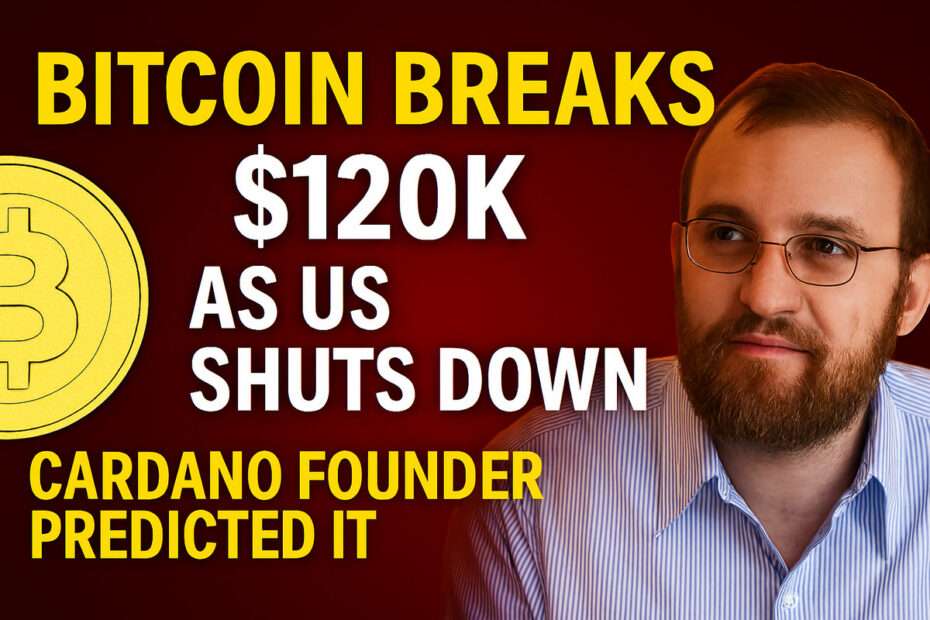Amid a sudden U.S. government shutdown, Charles Hoskinson, the founder of Cardano, has reinforced his bullish stance on Bitcoin, projecting that its value could climb to $250,000 by mid-2026. He points to the very geopolitical and economic instability now unfolding as a primary catalyst for such growth.
Cardano founder explains why Bitcoin price will hit $250k by mid 2026. pic.twitter.com/cdZHbMhfZX
— Altcoin Daily (@AltcoinDaily) October 2, 2025
Government Shutdown Ignites Market Uncertainty
The shutdown commenced on October 1st following a Senate vote that blocked a stopgap funding bill, leaving federal agencies without appropriations and placing approximately 150,000 employees at risk of furlough. The financial markets responded with immediate turbulence.
As the news broke, S&P 500 futures dropped sharply in early trading, while investors seeking safety in traditional havens pushed the price of gold upward. In this climate of uncertainty, Bitcoin experienced a notable surge, climbing more than 2% overnight to breach the $120,000 threshold the following day.
The situation leaves policymakers and investors navigating in the dark. Deutsche Bank strategist Jim Reid cautioned in a client note that the absence of critical official data on employment and inflation creates a state of “complete blindness.” Analysts widely view the shutdown as a direct contributor to the market’s volatility.
Matt Mena, a strategist at 21Shares, suggests that the delayed economic data could pressure the Federal Reserve to enact a 25-basis-point interest rate cut as early as October, potentially followed by another in December. He notes that such a shift, characterized by lower real yields and a weaker U.S. dollar, has historically created a favorable environment for Bitcoin.
Bitcoin’s Role in a Fragmenting World
Hoskinson’s prediction aligns with his long-held view that geopolitical fragmentation strengthens the case for decentralized digital assets. Speaking from the TOKEN2049 conference, he referenced the U.S. government’s public acknowledgment of Cardano, suggesting a growing institutional recognition of cryptocurrencies.
As tensions between major powers like the U.S., Russia, and China complicate international trade, reliance on conventional banking systems becomes increasingly politically constrained. In this context, Hoskinson suggests that digital assets like Bitcoin offer a neutral, global settlement layer operating outside these restrictions.
This perspective is echoed by analysts like Greg Magadini of Amberdata, who described the shutdown as a potential “catalyst” for Bitcoin. Its ultimate impact, however, depends on whether investors primarily view Bitcoin as a hedge against dollar instability or as a risk asset. For the moment, the reaction was decisively positive: Bitcoin rose nearly 4% within 24 hours, with other major cryptocurrencies like Ethereum and Solana posting even larger gains.
Broader Economic Implications
The longer the shutdown persists, the more severe the consequences are expected to be for U.S. economic growth. Economists at Oxford Economics, including Ryan Sweet, estimate that each week of closure could shave 0.1 to 0.2 percentage points from GDP. A prolonged, full-quarter disruption could reduce growth by as much as 2.4 percentage points.
This potential economic contraction increases the likelihood of further monetary easing from the Federal Reserve. Such conditions may, in turn, accelerate capital flows into digital assets as investors seek alternatives. The current crisis not only validates arguments about Bitcoin’s utility in times of instability but also reflects a broader trend of convergence between traditional finance and the crypto sphere. With tech giants and payment processors like Visa and Mastercard signaling growing interest, the industry lines are blurring, lending an air of legitimacy to the entire asset class during a period of profound uncertainty.
Maybe you would like other interesting articles?

